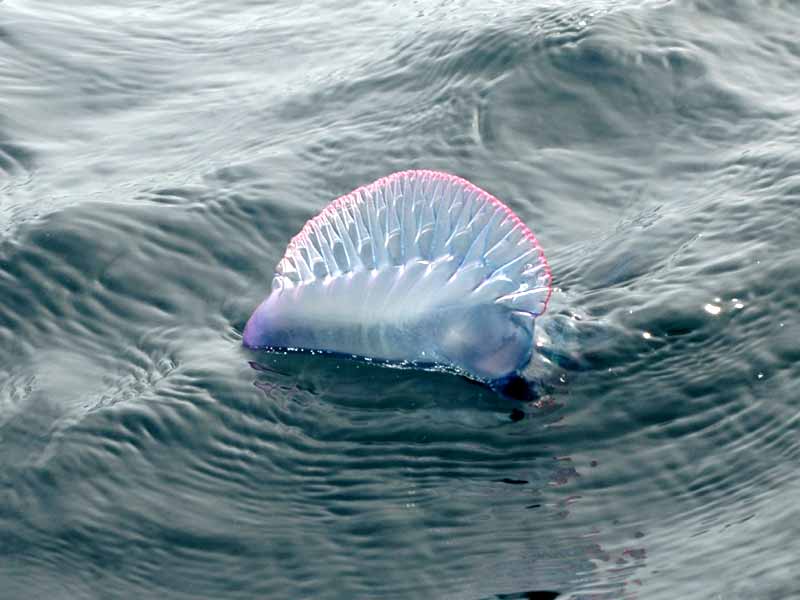Portuguese man o' war (Physalia physalis)
Distribution data supplied by the Ocean Biodiversity Information System (OBIS). To interrogate UK data visit the NBN Atlas.Map Help
| Researched by | Jessica Heard | Refereed by | Admin |
| Authority | (Linnaeus, 1758) | ||
| Other common names | - | Synonyms | - |
Summary
Description
Recorded distribution in Britain and Ireland
Physalia physalis is common in the warm waters of the Atlantic. However, individuals are sometimes driven by prevailing winds to the coasts of Britain and Ireland, especially southwest coasts.Global distribution
-Habitat
A pelagic warm water species driven into to shore by winds and currents.Depth range
-Identifying features
- Physalia physalis has a single, highly distinguishable, gas filled float (the pheumatophore), unlike many other siphonophores which rely on a group of swimming bells for floatation.
- Physalia physalis has contractile tentacles that can reach 10-20 m in length when extended.
- The crest of the purple float has a shot of pink running through it.
Additional information
Even though individual Physalia physalis are not an unusual sight on the coasts of Britain and Ireland, mass standings are uncommon, occurring only 3 or 4 times a century (Wilson, 1947). The sting of Physalia physalis causes severe pain, skin lacerations, convulsions, respiratory distress and in some cases death (Williamson et al., 1996). The sting remains potent even after death and the tentacles should not be touched. Portuguese man o'war are carnivorous feeding mainly on small crustaceans and larval fish (Kirkpatrick & Pugh, 1984).Listed by
- none -
Bibliography
Crothers, J. A., 1997. A key to the major groups of British marine invertebrates. Field Studies, 9, 1-177.
Howson, C.M. & Picton, B.E., 1997. The species directory of the marine fauna and flora of the British Isles and surrounding seas. Belfast: Ulster Museum. [Ulster Museum publication, no. 276.]
Kirkpatrick, P.A., & Pugh, P.R., 1984. Siphonophores and Velellids London: Academic Press. [Synopses of the British Fauna No. 29.]
Ruppert, E.E. & Barnes, R.D., 1994. Invertebrate zoology (6th ed.). Fort Worth, USA: Saunders College Publishing.
Williamson, J.A., Fenner, P.J., Burnett, J.W. & Rifkin, J.F., 1996. Venomous and poisonous marine animals: a medical and biological handbook. Sydney: University of New South Wales Press.
Wilson, D.P., 1947. The Portuguese man-o-war, Physalia physalis L. in British and adjacent seas. Journal of the Marine Biological Association of the United Kingdom, 27, 139-172.
Datasets
Fenwick, 2018. Aphotomarine. Occurrence dataset http://www.aphotomarine.com/index.html Accessed via NBNAtlas.org on 2018-10-01
Isle of Wight Local Records Centre, 2017. IOW Natural History & Archaeological Society Marine Invertebrate Records 1853- 2011. Occurrence dataset: https://doi.org/10.15468/d9amhg accessed via GBIF.org on 2018-09-27.
Marine Conservation Society, 2018. UK Jellyfish Sightings from 2003 to 2015. Occurrence dataset: https://www.mcsuk.org/ accessed via NBNAtlas.org on 2018-10-01.
NBN (National Biodiversity Network) Atlas. Available from: https://www.nbnatlas.org.
OBIS (Ocean Biodiversity Information System), 2025. Global map of species distribution using gridded data. Available from: Ocean Biogeographic Information System. www.iobis.org. Accessed: 2025-04-03
South East Wales Biodiversity Records Centre, 2023. SEWBReC Marine and other Aquatic Invertebrates (South East Wales). Occurrence dataset:https://doi.org/10.15468/zxy1n6 accessed via GBIF.org on 2024-09-27.
Citation
This review can be cited as:
Last Updated: 20/10/2006




